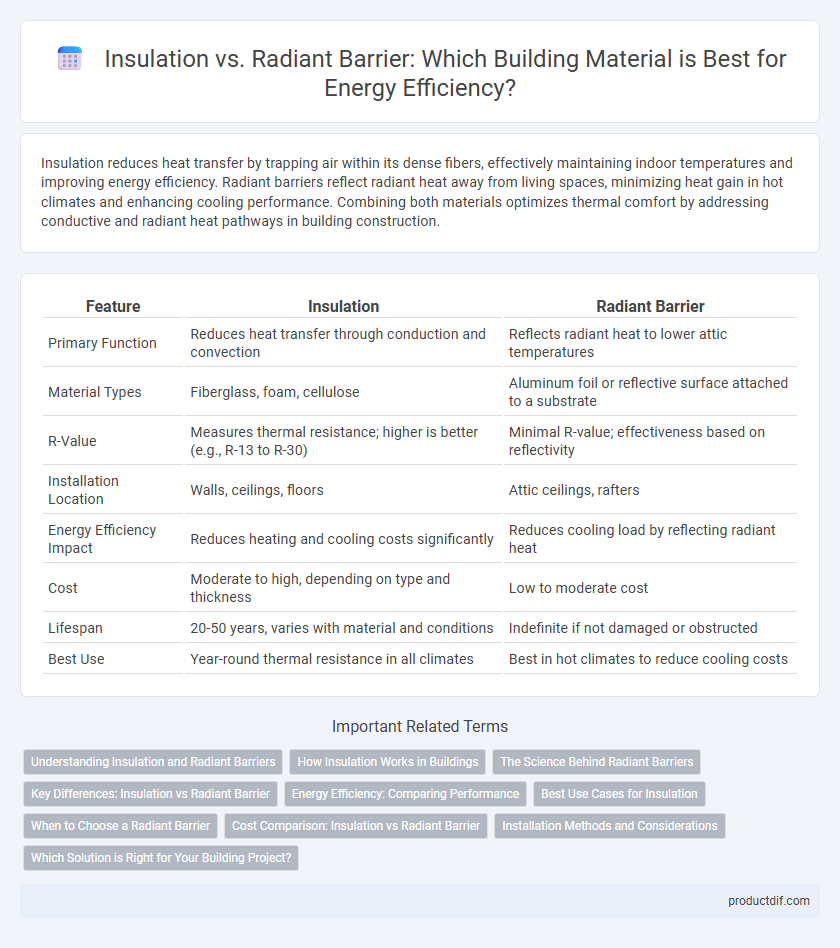Insulation reduces heat transfer by trapping air within its dense fibers, effectively maintaining indoor temperatures and improving energy efficiency. Radiant barriers reflect radiant heat away from living spaces, minimizing heat gain in hot climates and enhancing cooling performance. Combining both materials optimizes thermal comfort by addressing conductive and radiant heat pathways in building construction.
Table of Comparison
| Feature | Insulation | Radiant Barrier |
|---|---|---|
| Primary Function | Reduces heat transfer through conduction and convection | Reflects radiant heat to lower attic temperatures |
| Material Types | Fiberglass, foam, cellulose | Aluminum foil or reflective surface attached to a substrate |
| R-Value | Measures thermal resistance; higher is better (e.g., R-13 to R-30) | Minimal R-value; effectiveness based on reflectivity |
| Installation Location | Walls, ceilings, floors | Attic ceilings, rafters |
| Energy Efficiency Impact | Reduces heating and cooling costs significantly | Reduces cooling load by reflecting radiant heat |
| Cost | Moderate to high, depending on type and thickness | Low to moderate cost |
| Lifespan | 20-50 years, varies with material and conditions | Indefinite if not damaged or obstructed |
| Best Use | Year-round thermal resistance in all climates | Best in hot climates to reduce cooling costs |
Understanding Insulation and Radiant Barriers
Insulation materials, such as fiberglass or foam, reduce heat transfer by trapping air within their structure, effectively slowing conductive and convective heat flow. Radiant barriers, typically made from reflective foil, minimize heat gain by reflecting radiant infrared energy away from living spaces. Understanding the distinct functions of insulation and radiant barriers is crucial for optimizing energy efficiency and thermal comfort in building design.
How Insulation Works in Buildings
Insulation works in buildings by reducing heat transfer through conduction, convection, and radiation, maintaining indoor temperature stability. Common insulation materials like fiberglass, cellulose, and foam trap air within their structure, creating a thermal barrier that slows heat flow. Effective insulation lowers energy consumption for heating and cooling, enhances occupant comfort, and reduces utility costs.
The Science Behind Radiant Barriers
Radiant barriers function by reflecting radiant heat rather than absorbing it, using materials with low-emissivity surfaces such as aluminum foil to achieve reflectivity rates of up to 97%. Unlike traditional insulation that resists conductive and convective heat flow, radiant barriers reduce heat transfer by reflecting energy in the infrared spectrum, effectively lowering cooling loads in hot climates. This scientific principle allows radiant barriers to enhance energy efficiency when installed in attics, walls, or roofs by minimizing radiant heat gain inside buildings.
Key Differences: Insulation vs Radiant Barrier
Insulation primarily reduces heat transfer by slowing airflow and conduction, using materials like fiberglass, foam, or cellulose. Radiant barriers reflect radiant heat away from living spaces, typically composed of aluminum foil or reflective coatings. Key differences include insulation's focus on thermal resistance (R-value) versus radiant barrier's efficiency in reflecting infrared radiation to reduce heat gain.
Energy Efficiency: Comparing Performance
Insulation materials like fiberglass or foam reduce heat transfer by trapping air, improving overall energy efficiency by maintaining consistent indoor temperatures and reducing HVAC loads. Radiant barriers reflect radiant heat, particularly effective in hot climates by minimizing heat gain through roofs and attics, thus lowering cooling costs. Combining insulation with radiant barriers often yields superior energy performance by addressing both conductive and radiant heat transfer mechanisms.
Best Use Cases for Insulation
Insulation is best used in walls, attics, and floors to reduce heat transfer by trapping air, making it ideal for maintaining consistent indoor temperatures and improving energy efficiency in both cold and hot climates. It performs well in environments where thermal resistance (R-value) is critical for minimizing heat loss or gain. Unlike radiant barriers, which reflect radiant heat primarily in attics, insulation provides comprehensive thermal resistance across multiple building components, enhancing overall comfort and lowering heating and cooling costs.
When to Choose a Radiant Barrier
Radiant barriers are most effective in hot climates where reducing cooling costs is a priority, as they reflect radiant heat away from living spaces. They are ideal for attics with high sun exposure, helping to lower attic temperatures and improve overall energy efficiency. In contrast to traditional insulation, radiant barriers specifically target heat transfer by radiation rather than conduction or convection.
Cost Comparison: Insulation vs Radiant Barrier
Insulation materials such as fiberglass or cellulose typically offer higher upfront costs but provide long-term energy savings by reducing heat transfer through walls and ceilings. Radiant barriers, often made from reflective aluminum foil, generally have lower initial installation expenses but mainly reduce radiant heat, making them more effective in hot climates with significant sun exposure. Evaluating cost-effectiveness depends on climate, building design, and energy efficiency goals, with insulation being a more comprehensive solution and radiant barriers serving as supplemental protection.
Installation Methods and Considerations
Insulation materials such as fiberglass batts, spray foam, and cellulose require precise cutting and fitting within wall cavities or attics to minimize gaps and ensure thermal efficiency. Radiant barriers, typically aluminum foil sheets, are installed on attic rafters or roof decks with staples or adhesives to reflect radiant heat away from living spaces. Proper ventilation must accompany radiant barriers to prevent moisture buildup, while insulation demands moisture-resistant barriers or vapor retarders depending on the climate zone.
Which Solution is Right for Your Building Project?
Insulation materials such as fiberglass, foam board, and spray foam slow heat transfer by trapping air within their structure, making them ideal for maintaining consistent indoor temperatures and reducing energy costs. Radiant barriers, typically aluminum foil sheets, reflect radiant heat away from building surfaces and are most effective in hot climates with significant sun exposure, especially in attics. Choosing the right solution depends on your building project's climate zone, thermal performance goals, and budget, with many projects benefiting from a combination of both insulation and radiant barriers for optimal energy efficiency.
Insulation vs Radiant Barrier Infographic

 productdif.com
productdif.com